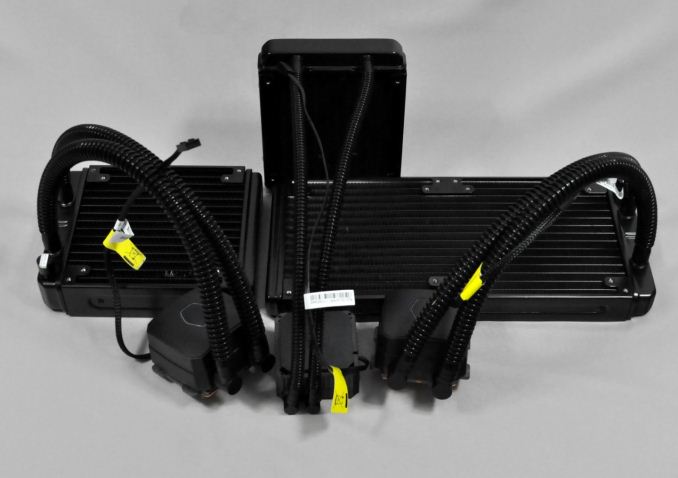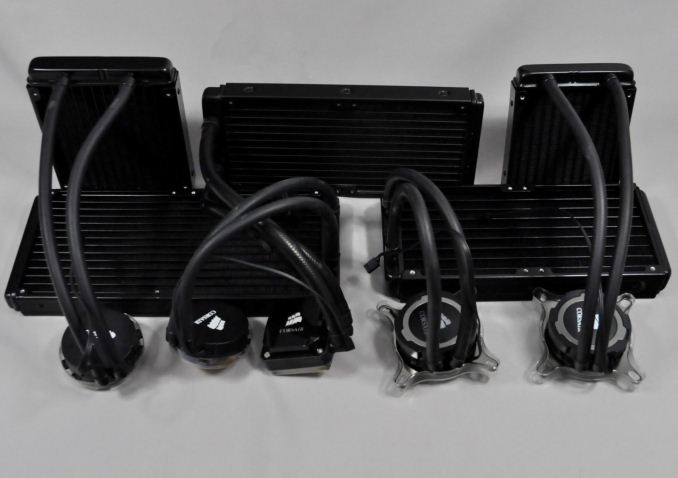Closed Loop AIO Liquid Coolers: 14-way Mega Roundup Review
by E. Fylladitakis on February 12, 2014 7:00 AM ESTCooler Master
It would seem that Cooler Master simply wanted to create the best performing AIO coolers available. In that respect, they certainly managed to do so, as their Nepton series coolers are constantly at the top of our high load thermal performance charts. On the other hand, one would have to be at least partially deaf in order to use these coolers with the fans anywhere near their maximum speed. Even with their voltage reduced down to 7V, both kits are rather noisy. It is not possible to run these kits quiet even if you reduce the voltage even further, as the fans are clearly audible from 1 meter away even at just 4.7V, the minimum voltage required to start them. Therefore, we simply cannot recommend them to anyone seeking a quiet cooling solution.
The Seidon 120V however is an entirely different product. Priced at just $49.99, it is more of an alternative to an average air cooler than competition for liquid cooling solutions. It fares relatively well at lower loads but its performance diminishes with thermal loads greater than 150W. With an average thermal resistance slightly above 0.014 °C/W, it will most likely be unable to compete with most extreme performance air coolers, and it has a particularly noisy pump, making it noisier than other 120mm AIO coolers. However, it has other merits, as it does not stress the motherboard with its weight and it requires very little space around the CPU area, making it ideal for special builds and/or systems that are moved around a lot.
Corsair
Corsair has such a vast selection of AIO cooling products that we could make a roundup just for them. Each of the five coolers that they shipped us for this roundup displays entirely different behavior; thus, each of them is suitable for a different type of user.
With the H75 Corsair is offering a compact 120mm AIO cooler but with two 120mm fans for extra performance. The H75 performs relatively well, although it generally does better at thermal loads lower than 150W due to the low capacity of its small radiator. The use of two fans however increases the noise of the system, giving the advantage to Enermax's Liqmax 120S if low-noise operation is the top priority.
The 140mm H90 on the other hand displays great all-around performance and very low noise levels. Even with its fan constantly running at maximum speed, the H90 can be considered fairly discreet and is comfortable for everyday use. If quiet computing is what drives you, the H90 deserves a very strong consideration.
Corsair informed us that the H100i is their most popular AIO cooler and we can see why. Despite its size, the H100i easily competes with coolers using significantly larger radiators. The stock fans have a wide operating range and the USB interface allows the user to adjust the performance/noise ratio to meet his or her exact needs. Furthermore, the size of the radiator makes the H100i compatible with a relatively wide array of cases.
After looking at the performance figures of the H100i, we felt disappointed by the performance of the newly released H105. The H105 hardly performs much better and it only does so when the thermal load is very high. Unfortunately, the thicker radiator can create compatibility issues and it also is more expensive than the H100i, all while lacking the USB interface that the H100i has. It is hard to recommend the H105 over the H100i for the slightly better thermal performance alone, unless of course maximum thermal performance is virtually the only concern of the user and a larger radiator cannot fit into the system.
Finally, the last AIO cooler from Corsair that we have tested, the Hydro H110, possibly stands as the performance winner of this roundup. Although it does not have the best thermal performance, it is very close to the top of the charts and manages to do so while maintaining very low noise levels. However, the size of the radiator limits the compatibility of the cooler with only a handful of cases currently available and, considering that the retail price of the H110 is over $125 at the time of this review, it is a costly thermal solution.












139 Comments
View All Comments
Dustin Sklavos - Wednesday, February 12, 2014 - link
Good lord.If I'd known my successor would produce results this thorough I'd've stepped aside a long time ago.
Really well done piece of work.
E.Fyll - Wednesday, February 12, 2014 - link
Thank you for the praise Dustin, yet I still stand unworthy of it. :)Dustin Sklavos - Wednesday, February 12, 2014 - link
I'm enjoying your work tremendously. Now that I'm at Corsair I'm glad we have someone we can send case/cooling/PSU hardware to that meets and beats the AnandTech standard.creed3020 - Wednesday, February 12, 2014 - link
Yeah Dustin....I have seriously enjoyed your labors here at AT and do miss them. Your successor has changed the paradigm so much that it's hard to compare, but it's a awesome reboot to this area of reviews here at AT.I, however, have to agree with many other commenters that a secondary dataset produced with the same 120mm/140mm fans does have it's merit as it will provide an objective evaluation of the radiator and pumps. This is one area where I am really curious to see quality differences in the products. I am fully aware that each OEM is very careful in their selection of a fan which matches their product. This is not done by lottery, that much is clear to me. The OEM behind the Silverstone/Enermax product intrigues me, as I am a fan of Silverstone products and use their cases exclusively for all of my desktops, gaming PCs, and HTPCs. The Tundra's seems like they are ripe for a revision!
BigLeagueJammer - Wednesday, February 12, 2014 - link
Under Noise Level Reference Values, your first one of <35dB(A) being "Virtually inaudible" doesn't match up with most sources I've seen. Most rate that as "very quiet" and say the limit of human hearing as 10 db(A). If other sources say things like a ticking watch is around 20 db(A) which in a quiet room is easy to hear, then 35 seems too high for your qualification of "virtually inaudible".E.Fyll - Wednesday, February 12, 2014 - link
True, I am afraid that the lot of "copy/paste-ing" online has produced a lot of bad information going around. Some are works of fiction, some are misinterpretations of confused people, some...I don't even want to know.So, copying my answer from above:
"Sub-35 dB(A) levels are generally impossible to notice by a human ear. Sub-30 dB(A) levels are next to impossible to record with anything less than science lab-grade equipment. There is no handheld or desktop dB(A) meter that can perform such readings. If you have seen reviews stating sub-30 dB(A) levels, make sure to check their methodology (given that there is any). Either the meter cannot read lower than 30 dB(A) (and/or will display a bogus reading, as most cheap Chinese meters do) and the review is a fictional text or their methodology is based on dB readings, not dB(A) readings, which is useless to a consumer."
I think it will suffice for me to say that you cannot possibly hear what an instrument designed for this specific purpose cannot even record. In theory, the human hearing threshold is 1 dB(A); in practice however, that is true only for specific frequencies. The background noise of a typical room is almost always above 32-33dB(A).
Jon-R - Wednesday, February 12, 2014 - link
What is your opinion on the tests done over at SilentPCReview? They test using lab-grade equipment. A rundown can be found here: http://www.silentpcreview.com/article875-page2.htm...They use reference fans which measure around 13dBA at their slowest fan speeds, and they don't think highly of AIO water-cooling at all, as none of the tested ones have come close to the best air-coolers when it comes to quiet cooling.
E.Fyll - Wednesday, February 12, 2014 - link
From what I can see, they are using a highly sensitive microphone and a computer's sound card to record the results, connected through an amplifier. Although the equipment is very good, this is not "lab grade equipment" but just a customized setup. A very good setup nonetheless, including an anechoic chamber. They have a microphone with a self-noise of 8 dB, which measures 11 dB(A) inside the aforementioned anechoic chamber.It will suffice to say that their results are just in no way comparable to mine. Actually, as noise level measurements are environment-specific, you should only compare the results of a same setup, never in-between different setups. Unless they are all science labs with multiple ISO certifications, of course. Given that my room floor noise level is over 30 dB(A) and they are using a sub-12 dB(A) anechoic chamber, I believe that I do not have to stress how different the results out of these two setups are.
As far as equipment goes, for example, this is a cheap lab grade sound analyzer and still costs 5 times more than the whole setup that you showed me, microphones and secondary equipment aside:
http://www.nti-audio.com/en/products/flexus-fx100....
Jon-R - Wednesday, February 12, 2014 - link
But you're not saying that their measurements are inaccurate, only that they've got a significantly lower noise-floor than what you're using? So it boils down to the difference between what is considered silent? Because 30dBA is louder than their reference fan it its loudest setting, and far beyond what they consider acceptable. Just as a reference, they measured 43 dBA for the Silverstonde TD03 at 12v, and 30 dBA at 7v.E.Fyll - Wednesday, February 12, 2014 - link
"Inaccurate" is a harsh word when it comes to sound pressure level measurements. Although I would not hesitate to use this word for most other types of tests, there are far too many variables at stake here. I believe that their setup may be better than mine. I am just using a good handheld sound level meter, with the product positioned in the middle of a standard room.I would simply stick with "different".
Sound levels are additive. If you have a noise source of 20 dB(A) and added another source of 20 dB(A), the room noise would not be 20 dB(A) but 23 dB(A). A third source would make it 24.8 dB(A) and so on. So, a fan that would measure 18 dB(A) inside an 12 dB(A) anechoic chamber, will still add to the 30.4 dB(A) floor noise of my room. The difference is the magnitude, as the scale is logarithmic. As you said, the TD03 added about 18 dB(A) and 30 dB(A) to their setup, when it adds 8.3 dB(A) and 17.7 dB(A) to mine, because of the higher background noise. These differences are in no way comparable to each other; that is only possible when the scale is linear. The further you move up the decibel scale, the largest the increase of SPL becomes per single decibel.